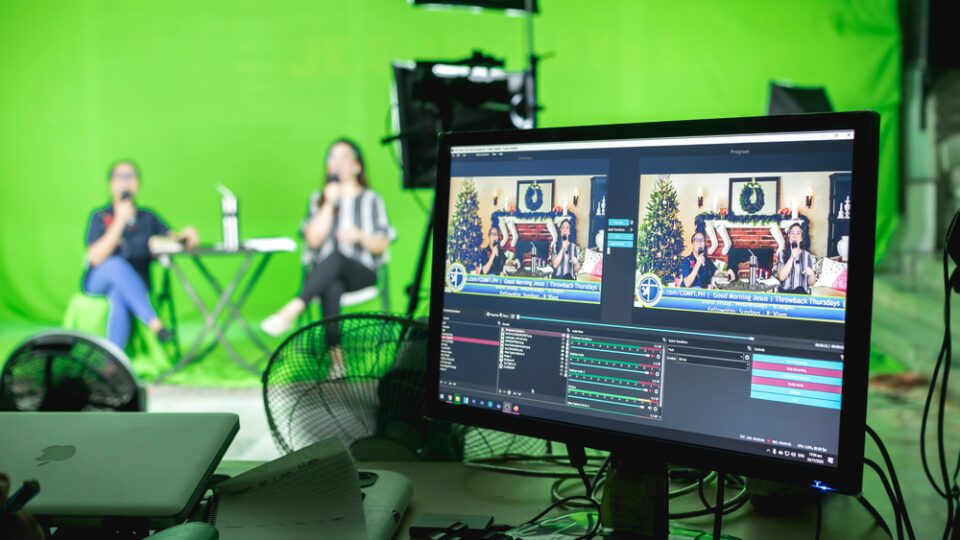Livestreaming, also known as live commerce, is still emerging in Western markets, particularly when compared to the booming Chinese livestreaming market. But Coresight Research indicates that growth is imminent in the U.S. The firm predicts that the livestreaming ecommerce market for the country will total $32 billion by the end of 2023, nearly triple its 2021 size.
A combination of video stream, entertainment and real-time group chat, livestream shopping is a part of the much broader social commerce industry, which is currently $492 billion in size and expected to grow 3X as fast as traditional ecommerce, according to Jill Standish, Global Lead for Accenture’s Retail Industry Practice.
And why are livestreams so effective? Because they “combine some of the most important aspects of the in-store experience, such as interactive customer service, with the ease, convenience and pure entertainment factor of online shopping. That’s a potent combination,” Standish said in an interview with Retail TouchPoints.
For brands considering livestreaming or just starting to dip their toes in the water, experts recommend answering three basic questions that will shape their live commerce strategies. Additionally, they’ve identified the seven keys to perfecting the livestream experience, including choosing the optimal host, managing marketing, and which metrics are most valuable.
Executives seeking hard numbers about livestreaming’s power can look to Alibaba’s 11.11 festival in 2022 for proof. During the sales period, 62 influencer and retailer-run livestream channels surpassed RMB 100 million ($14.2 million) in sales, and another 632 surpassed RMB 10 million ($1.4 million), according to Retail TouchPoints analysis of the shopping holiday.
But it’s important to note that there are plenty of brands and retailers seeing the payoff from their own standalone investments, especially as consumers seek to blend the ease and flexibility of shopping online with the interactivity of shopping in-person.
“By providing interactivity and instant gratification, livestreaming generates excitement and allows viewers to interact more directly and be seen by their favorite brands, influencers and celebrities,” said Sara Alloy, Retail Experience Lead, North America at Publicis Sapient. “It also provides purchase security and the reinforcement of shopping with peers, which implicitly creates trust. Viewers don’t need to read reviews or watch an unboxing video; they can see product demos in real time and feel confident with their purchase.”
But before brands and retailers “press play” on their livestreaming efforts, they need to establish an overall vision for the experience. “While livestreaming can help create differentiation, they should consider what is unique to them to keep viewers watching,” Alloy advised. In other words, what feels specific to the brand or retailer, and rare to this moment and method of engagement? “Livestreaming can help strengthen brand position, increase perception of authenticity, and reach entirely new audiences and demographics — especially those interested in engaging with innovative and emerging technology.”
Building a Foundation for Live Commerce
As with any marketing channel or tactic, a sound livestream strategy starts with the fundamentals of brand marketing and storytelling. Bao Arakov, Livestreaming Analyst at Coresight Research, recommended that brands ask (and answer) three key questions:
1. “Who is our target consumer?”
“While social media and video-sharing platforms are dominating the space, our research found that each livestreaming channel gains a different age group of online users,” Arakov said in an interview with Retail TouchPoints. Gen Z and millennials are more likely to flock to Instagram or TikTok, while older millennials and Gen X are more familiar with the formats of shows from QVC, HSN and similar platforms. Knowing your primary audience will help establish a baseline not only for which platforms to use, but also the format and overall creative direction for the livestreams.
2. “What does our consumer want to listen to?”
“Consumers’ motivation varies across popular product categories,” Arakov explained. “For example, apparel, footwear and jewelry categories see the highest proportion of livestream viewers looking to discover new products or services, or to learn about products.”
Grocery retailers like The Fresh Market use livestreaming to feature new recipes and do cooking walk-throughs, and wellness/athletic brands like lululemon use livestreaming to feature unique courses and chats with experts. But there are truly no creative limits on the kind of approach a marketer takes. The key is ensuring that content always ladders up to a brand’s core mission and values, and reflects the core needs of consumers as they shop with that specific brand.
3. “Where should we broadcast?”
Retail companies globally use an average of 3.9 platforms for livestreaming, according to Coresight’s B2B livestreaming survey. Arakov noted that this “enables them to realize the benefits of each type of platform reaching a range of audiences.”
When these three questions are answered, they help establish the “what” and the “how” components of a brand’s livestreaming strategy. But the most critical piece of the puzzle, according to Alloy, is the “why.” “Retailers and brands should consider what outcome they’re looking for with livestreaming before choosing a strategy,” she said. “This includes considering not only the target audience but the goal for products. For example, is it a new product launch? Do you want to revitalize interest in a previous best seller? Or do you want to solicit feedback?”
Assessing the Expanding Livestreaming Tech Landscape
Once the foundation of their strategy is in place, brands need to determine their technology requirements, which may feel more complex as the livestreaming tech landscape blooms.
At a high level, Arakov emphasized the importance of customization, speed and scale. Brands should be able to record, launch and amplify livestreams seamlessly. While using social platforms allows brands to enter livestreaming quickly and with relatively low risk, brands could be missing out on the rich data and capabilities they will likely need to interact with consumers effectively and understand the true impact of their efforts.
“Retailers should consider the ancillary functionality they need, such as live chats, reactions, and the ability to bring a viewer live into their feed,” Alloy explained. “Retailers and brands should also look for a solution that allows for easy tracking of metrics like total viewership, at which points sales increase and when viewers are most likely to drop off, as well as a tool that provides the ability to rewatch the event in totality or summary for further analysis. This will help when tailoring future events to be most effective.”
Arakov noted that having an owned platform gives brands greater creative control over their livestream experiences, and also offers “greater access to first-party data that can be used to generate customer insights and improve personalization.” This rich data is especially valuable as brands promote their livestreams. To take advantage of social platforms’ big advantage — easy access to a much larger and actively engaged audience that could help with acquisition efforts — brands should look for solutions that allow for seamless sharing and amplification to these networks.
7 Keys to Perfecting the Livestream Experience
Strategy and technology are the core of livestreaming efforts, but there are seven tactical areas that brands need to address as they put their plans into motion.
The host: “Companies are prioritizing product and brand knowledge in their selection of a livestreaming host,” Arakov said. However, the ideal hosts varies depending on goals as well as product categories. In-house staff are an extremely cost-effective option and allow brands to showcase the expertise of their people. Store associates in particular are being spotlighted as ideal “stars” for livestreams, as they create a direct connection to stores and help nurture more direct relationships with consumers. Arakov noted that these hosts are a great fit for apparel and cosmetics.
Conversely, influencers can help build buzz across new and broader audiences. This is especially valuable as brands drop new collections, limited-edition products or launch new campaigns. Micro- and nano-influencers “can generate a more personal and trusted connection with audiences at lower costs” than their macro counterparts, Arakov explained. “They can be seen as trustworthy sources of ‘real’ opinions as opposed to brand-created marketing.” These hosts are most popular among grocery and general merchandise retailers, according to Coresight research.
The format: “Brands will want to decide which content format the livestream will take,” Alloy said. “Product launches, reviews, tutorials, interviews and behind-the-scenes streams are just a few popular formats. Retailers and brands may also want to try giveaways, limited time offers/discounts or games to engage viewers. Remember, the longer the viewer is engaged, the more conversion a brand can expect.”
The environment: Location plays a critical role in creating an overall “vibe” for the livestream. In many cases, a brand studio or tidy space allows creators to effectively showcase products and hosts. However, for streams that want to feature people, events or localized experiences, a store would be the best fit. “Bricks-and-mortar will play an important role in livestreaming, as having a store presence legitimizes the brand,” Standish said. “What better way for retailers attempting to lure customers back into stores than to make the stores themselves the livestream sites?”
The marketing: “Having a good marketing strategy in place is crucial for livestreams to be successful,” Standish said. “Letting people known of an upcoming show through newsletters, emails, websites, apps, push notifications and social media, and providing links and information on paid social media, are all tactics retailers will need to consider.”
Brands also should think about what happens after the livestream, especially because they often can be used to inspire one-time impulse purchases. Alloy noted that “it will be important to plan how retailers and brands will re-attract audiences and drive loyalty in the long run.”
The metrics: There are a few common data metrics to track a shoppable livestream performance, including viewership, engagement rate, add-to-cart rate and sales, according to Arakov. However, Alloy noted that KPIs can vary based not just on the overall goals of the brand but the intentions for the specific livestream. “Any measure that provides tactical and data-driven insight into the content, format, host, audience and which products resonate best in the format can form the basis for a strong KPI,” said Alloy. “KPIs should be updated regularly and become more nuanced as brands and retailers livestream more often and evolve their own methods and platform choices.”
Unsurprisingly, Coresight research indicates that revenue creation is a top priority, which means most retail executives are looking at website visits, engagement and overall sales.
The processes: Establishing repeatable processes and procedures helps livestreaming scale. That’s why Alloy recommends that brands and retailers establish livestream content guidelines, platform parameters, content calendars and review processes. They also should establish a process for responding to consumers’ questions, concerns or critiques. Having firm procedures in place ensures compliance and consistency, whether livestreams are done by internal teams, agencies or influencers.
The innovation: Because livestreaming is such a new space, iterating and improving is key, especially for newcomers to the space. Standish recommended that brands just entering the space may see the most value from experimenting with a regular schedule of live events, to “test products, tracking performance using real-time predictive analytics to derive insights into audiences, content, products, formats, hosts and timing.” And as brands learn more about what works (and what doesn’t) in their livestreaming strategy, they can begin to test innovative formats such as AR and VR, which “make the shopping experience even more immersive and enable buyers to see a product from every angle.”













